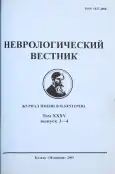Синдром беспокойных ног - системная патология построения и исполнения движения
- Авторы: Иваничев Г.А.1, Иваничев В.Г.1, Бойко С.П.1
-
Учреждения:
- Казанская государственная медицинская академия
- Выпуск: Том XXXV, № 3-4 (2003)
- Страницы: 45-51
- Раздел: Оригинальная статья
- URL: https://journal-vniispk.ru/1027-4898/article/view/100115
- DOI: https://doi.org/10.17816/nb100115
- ID: 100115
Цитировать
Полный текст
Аннотация
Впервые патогенез синдрома беспокойных ног рассмотрен с позиций системной патологии нервной системы — рассогласования программы построения движения в центральной нервной системе и активности периферических исполнителей в условиях латентного миофасциального триггерного пункта икроножных мышц. Актуальный периферический фактор — миофасциальный триггерный пункт — в генезе синдрома беспокойных ног является запускающим и поддерживающим звеном. Развертывание типичной картины синдрома беспокойных ног происходит в условиях минимальной дисфункции мезодиэнцефального отдела большого мозга — формирование генераторов патологически усиленного возбуждения на различных уровнях системы построения движения.
Ключевые слова
Полный текст
Открыть статью на сайте журналаОб авторах
Г. А. Иваничев
Казанская государственная медицинская академия
Автор, ответственный за переписку.
Email: info@eco-vector.com
Россия, Казань
В. Г. Иваничев
Казанская государственная медицинская академия
Email: info@eco-vector.com
Россия, Казань
С. П. Бойко
Казанская государственная медицинская академия
Email: info@eco-vector.com
Россия, Казань
Список литературы
- Аверьянов Ю.Н., Подчуфарова Е.В. // Неврол. журн. — 1997. — № . 3.—С. 12—16.
- Анохин П.К. Очерки по физиологии функциональных систем. — М.,1975.
- Бернштейн Н.А. Физиология движений и активность. — М., 1990.
- Иваничев Г. А. Мануальная медицина. — М., 2003.
- Иваничев ГА., Старосельцева Н.Г. Миофасциальный генерализованный болевой (фибромиалгический) синдром. — Казань, 2002.
- Иваничев ГА., Овчинников А.В. // Казанский мед. ж. — 2001. — №5. —С. 336—340.
- Крыжановский Г.Н. Общая патофизиология нервной системы. —М., 1997.
- Нурмухаметова Е. // Русский мед. ж. — 1997. — № 7.
- Amar K. // Hosp. Med. — 2001. — Vol. 62(8). — р. 487—489.
- Hickey J. // Can. Fam. Physician. — 2000. —Vol. 46. — P. 1762—1763.
- Sateia M.J., Doghramji K., Hauri P.J., Morin C.M. // Sleep. — 2000. Vol. 23(2). — P. 243—308.
- Walters A.S. // Mov. Disord. — 1995. — Vol. 10 (5). — P. 634—642.
- Winkelmann J. // Arch. Neurol. — 1999. —Vol. 56 (12). — P.1526—1527.
- Winkelmann J., Trenkwalder С. // Nervenartz. — 2001. — Vol. 72 (2). — P. 100—107.
- Zai C., Wigg K.G., Barr C.L. // Semin. clin. Neuropsychiatry. — 2000. — Vol. 5 (1). — P. 33—43.
Дополнительные файлы






